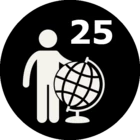Is there a way to create a table of attributes from a geotiff? I would like to create a table of pixel values where each pixel has an associated elevation. Elevations can be negative or positive and are from LIDAR. The table can be a .txt file. Zonal Spatial statistics with ESRI can create a table of attributes but the geotiff cannot have float values. The elevations for my geotiff range from about -10.00001 to 24.00001 so these valuse will not work with spatial analyst. I would also like to create statistics for specific elevation classes. any advice welcome
thanks






